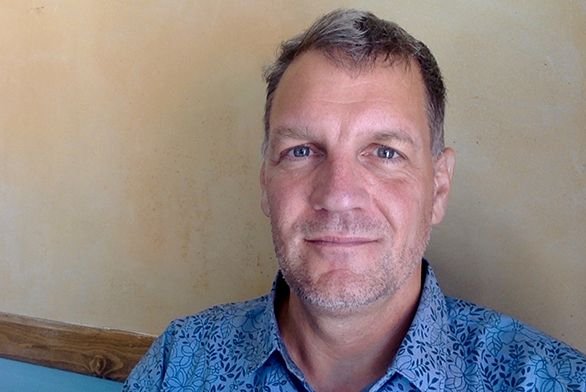What is a Great Book? One Alum Seeks a New Definition
November 6, 2018 | By Anne Kniggendorf

Since the founding of the New Program 80 years ago, debate about what constitutes a Great Book has raged and receded periodically, occasionally resulting in the addition of a few new authors to the list, but often not, deferring to the standards set forth by Stringfellow Barr and Scott Buchanan.
According to Stuart Patterson (SF92), it’s time to restart the conversation. He recently delivered a lecture entitled “Why and What Should We Read?” as part of the JohnnieTalks series during Santa Fe’s Homecoming Weekend. But while his lecture introduced his thoughts on the idea of “Great Books,” he wants to take it a step further.
Patterson is a professor at the Shimer Great Books School, now part of North Central College in Naperville, Illinois, and considers himself a “dedicated member of the Great Books community.” He has taught his school’s core curriculum several times over the past 14 years, a curriculum he says “any Johnnie would recognize.” And while there are some differences in the Shimer program, such as a year of electives focusing on either humanities, natural sciences, social sciences, or liberal studies, Patterson has no desire to change the structure of the Program at St. John’s.
But the books? He’s not so sure Johnnies are reading all the right ones.
“A good community doesn’t ignore people that it includes, it brings them in as part of the dialogue,” he says. “It pays respect to its ancestors, its forbearers, where it comes from.”
In that respect, he defers to something Barr and Buchanan themselves noted: “It should be added that any limited list of the classics must always remain open to revision. There is no better way of revisiting it than its continuous use in teaching in a college.”
Patterson believes that one of the reasons we study the Great Books is to be better members of the community—and, as such, we must consider a wider pool of writers and thinkers.
“Instead of working toward some kind of truth, I would say my prescription for a kind of goodness in the concoction of a curriculum is to inquire into how we are most whole by way of what we read,” he says. “‘Goodness’ in the curriculum would focus on the care and attention it showed to its members, rather than a ‘greatness’ that imposes a single standard on both the community and the books it reads.”
Still, there has been an effort to better represent the community by including more women and writers of color. The Program has expanded to include Frederick Douglass, Virginia Woolf, W.E.B. DuBois, Booker T. Washington, and Flannery O’Connor, among others, and students gravitate toward more diverse and contemporary works in extracurricular study groups.
Patterson, however, believes there remains much work to be done.
“It would make a lot of difference if students were given in their senior year some sense that the world really did change in the 19th and through the 20th century,” he says. “It really did open up.”
He contrasts the plasticity of the book list at St. John’s with the devotion shown to sacred works like the Bible, Qur’an, or Book of Mormon. Loyalty to both religious and Program texts demands increasingly “fancy footwork” to keep the works relevant, he says.
“What I wanted to say [in the JohnnieTalk] was: Climb down from the heights. Continue to read the Platos and the Aquinases and Dantes, but think about a community that is not attached to one book in a kind of religious sense, but has a religiosity about books that can be adaptive to historical change.”

